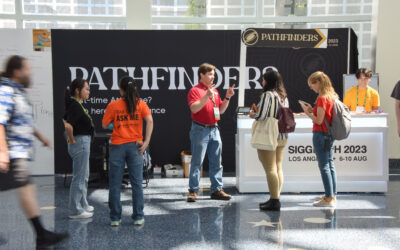photo by John Fujii © 2023 ACM SIGGRAPH
By Juan Miguel de Joya, ACM SIGGRAPH Practitioner Career Development Committee (PCDC)
It has never been a more exciting time to be in computer graphics and interactive techniques. Our practice has become more accessible and applicable to a broadening range of industries. With new innovations, improved computational power and infrastructure, and an evolving understanding and market for our work, there are more possibilities and opportunities for work in our fields.
At the same time, we are living in a period of unprecedented societal shifts. Technology is evolving at an accelerated pace, and while we, as technologists, will continue to anticipate and adapt to these changes, how we define meaning and value to our professional journey is a moving target that will be affected by other factors in our lives.
In this context of constant change, personal career development is a must have rather than a nice to have. But the reality is that career development rarely gets prioritized. Our day-to-day responsibilities often take precedence over our improvement, and investing in our future rarely feels as urgent as the issues in our inbox. Putting ourselves last can lead to our decreased engagement and enjoyment at work, which in turn leads to our skills and careers stagnating in the long term. In the short term, failing to spend on our professional development decreases our career resiliency in the face of external job impacts like layoffs and reorgs.
Becoming the professional we want to be means knowing what we want to do, who we want to be, and bridging the gap in between. These ideas were front of mind at the first ACM SIGGRAPH Practitioners Sessions, organized by the ACM SIGGRAPH Practitioner Career Development Committee (PCDC) at SIGGRAPH 2023. The goals of these sessions were to have open discussions, with like-minded peers, on professional development in our industries, and to help inform how ACM SIGGRAPH can better serve the needs of our practitioner community.
This article is the first in a series of posts on professional development discussions that were brought up during these sessions, followed by practitioner career development initiatives coming out of the organization in response. This first article focuses on how the PCDC defines who our practitioner target audience is and the challenges stemming from the current climate and culture for professional development. Future articles will reflect on the PCDC’s approach and action items toward topics such as navigating the current job market, translating research to practice, fostering a professional development body with like-minded peers, and engaging with interdisciplinary work among others.
Who Do We Serve? Defining the Practitioner
Being a practitioner means different things to different people. Practicing applied computer graphics and interactive techniques is not limited by the type of institution — academic and industry, for example — that one is most associated with professionally. A researcher can develop open-source rendering software and an engineer can discover a new approach for rendering that could fuel further research.
The consensus from the Practitioners Sessions is that practitioners are professionals who create, apply, and/or use technology that produces a direct effect or outcome in society. This could be anyone creating computer graphics software/hardware, who collaborates in the creation of a film or game, or who leverages existing applications to visualize and engage with digital twins, among others.
While practice and research equally contribute to the advancement and adoption of technology, the practitioner’s product is more immediately and broadly recognized in the short-term; an image visualization tool for medical diagnoses, for example, is more visible to a patient than the research which made such a system possible. Accordingly, users require accountability from practitioners that their products reflect and meet their needs. Although the work of the engineer and researcher is built on a body of scientific knowledge, it is the engineer who faces a malpractice lawsuit should their work fail.
A Changing Climate and Culture for Professional Development
What a career means to a professional in the past is different from what we want today.
In the past, a new hire would be expected to stay with their company throughout their career. Nowadays, the average employee stays at a job just over four years, with younger employees more likely to change jobs within a year. This is due to various factors such as career exploration, better pay and perks, company culture, and personal and/or socioeconomic circumstances among others.
Change and uncertainty are now a given in our careers. As a result, people are re-evaluating what they want out of work. For many, the traditional career ladder gives way to non-linear career moves where progression goes beyond promotion and allows people in develop on their own terms.
This change and uncertainty also affect how companies and organizations foster professional development in the workplace. A strong learning and development (L&D) program empowers employees with the skills and capabilities to do their job well and demonstrates to them that the company believes they are worth investing in. Yet creating conditions that motivate people and foster improvements in individual and organizational effectiveness is difficult with the current dynamic job market conditions. This leads to a widening mismatch between the job environment employees want and need to thrive and the one their organization can identify quickly and have capacity to support effectively.
Broader organizational operations notwithstanding, many teams are facing a great need for reskilling and recruiting on their teams. However, increasingly squeezed leadership are spending time they don’t have finding and retaining talent, staying informed and relevant in their field, and maintaining their day-to-day responsibilities to their team.
Professional Development With ACM SIGGRAPH
It can often be difficult to find the right direction for one’s continued career growth. What’s more, prioritizing and recognizing what one needs for professional development is not just difficult for people who want to be hired — it can be equally challenging for the people who want to hire them and the companies looking to grow and retain talent they hire.
The PCDC will be developing year-round career development resources for practitioners and for those who are interested in or aspire to the practice of computer graphics and interactive techniques as defined and scoped above.
The committee recognizes that it cannot, on its own, necessarily cover professional development in the context of all communities in computer graphics and interactive techniques. To that end, we will be actively reaching out to other existing communities, both within and outside of ACM SIGGRAPH’s organizational structure, to collaborate on such efforts.
The PCDC also recognizes we will not be able to cover all topics and may miss some informed points. We are open to hearing your perspective on how we, as a community, can grow together, and welcome your constructive feedback, suggestions, and/or your interest in volunteering through our feedback form.

Juan de Joya is a software developer engineer for the Developer Support Program at Autodesk, specializing in support for the Arnold renderer. He has worked on various areas in computer graphics for DigitalFish at Oculus and Google ATAP, Pixar Animation Studios, Walt Disney Animation Studios, the Visual Computing Lab of the University of California, Berkeley, and on AI for Good initiatives at the International Telecommunication Union, the UN agency on information and communication technologies. Juan has served as an ACM SIGGRAPH and SIGGRAPH volunteer since 2012, and is currently the chair of the Practitioner Career Development Committee for the organization and a member of the Practitioner Board of the Association for Computing Machinery (ACM).



